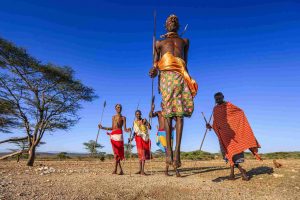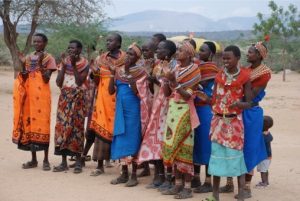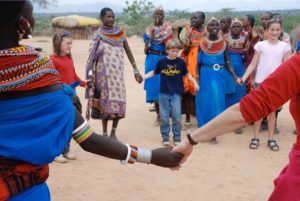Have you ever heard of the Samburu people? Being closely related to the Maasai, they are one of several tribes living in Samburu district, in Northern Kenya. Their semi-nomadic lifestyle centres on their cattle, sheep, goats and camels, which require them to frequently relocate every 5 to 6 weeks to find new grazing land, as the landscapes in Northern Kenya are dry and barren. Their portable self-built mud huts are then rearranged to form the settlements, called manyattas, that are surrounded by thorny fences for protection. Traditionally, the men of the families are the warriors, protecting the tribe and looking after the cattle. The women are responsible for looking after the children and their home and taking care everybody has food to eat and water to drink. Their diet is based on milk, vegetables and roots, and sometimes also including blood of their livestock, extracted without severely hurting the animal, while meat is only consumed on special occasions. The impressive, colourful dresses, face paintings and women-made jewellery, as well as a lot of dancing and singing (usually without instrumental music) are part of their ancient traditions.
This semi-nomadic lifestyle is interfered with nowadays, as the government pressures towards permanent settlement, which would have severe consequences for them: They would become dependent on others for survival, as their way of life is kept intact through the frequent resettlements. Therefore, the community members seek for different opportunities: There are activities offered within their protected land, that visitors can take part in, like staying at one of the community-run lodges and safari tours. It is important that you look specifically for offerings that are run by and benefiting the community, and not exploiting them, so please stay away from safaris that go to the villages of those people treating them like zoo animals!
Rather, look out for and support causes like the first community-owned and run elephant sanctuary in East Africa: community-focused conservation gained momentum in Kenya, where the landscape and natural resources are recovering now from the past. Self-governed community conservancies are developed, like the Reteti Elephant Sanctuary, which is rescuing and releasing abandoned elephant calves to reunite them with their mothers since 2016. It is a community-empowering initiative, offering Samburu people without educational background a possibility to make use of their assets, like the deep knowledge of nature. It provides a strong community involvement, educates the people, shifting their former rather negative picture of elephants to the positive, and provides jobs.
If you would like to find out how to visit the Sanctuary responsibly, in order to strengthen the community and protect the elephants, click here.
The sources of information and pictures can be found via the links below.
Reteti Elephant Sanctuary
Picture credit: Bartosz Hadyniak and Charlotte Louwman-Vogels





This Post Has 0 Comments